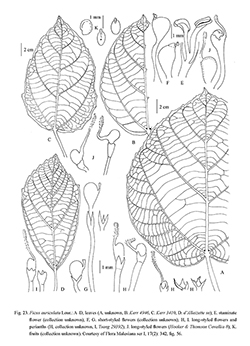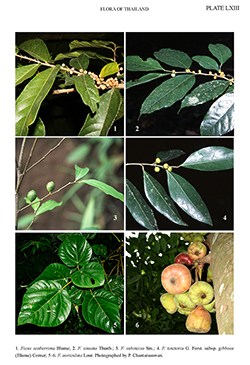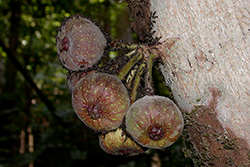e-Flora of Thailand
Volume 10 > Part 4 > Year 2011 > Page 559 > Moraceae > Ficus
SYO1. Ficus auriculata Lour.wfo-0000687425
Fl. Cochinch. 2: 660. 1790; Miq., Ann. Mus. Bot. Lugd.-Bat. 3: 296. 1867; Merr. & Chun, Sunyatsenia 2: 216. 1935; Corner, Gard. Bull. Singapore 19: 395. 1962; Corner, Philos. Trans., Ser. B, 281: 383, t. 7. 1978; C.C.Berg, Fl. Males., Ser. 1, Spermat. 17(2): 341. 2005; C.C.Berg, Thai Forest Bull. (Bot.) 35: 11. 2007. Fig. 23. Plate LXIII: 5–6.
Accepted Name : This is currently accepted.
Synonyms & Citations :
Description : Shrub or tree to 15(–20) m tall, tall ones becoming shortly buttressed. Leafy twigs 2–10 mm thick, whitish to brownish (appressed-)puberulous to subtomentose or glabrous, without nodal waxy glands; internodes hollow (or solid); periderm flaking off or persistent. Leaves spirally arranged to subdistichous; lamina cordiform, ovate, elliptic, oblong, subobovate or suborbicular, (6–)10–30(–40) by (3–)7–25(–32) cm, symmetrical, chartaceous to subcoriaceous, apex short-acuminate to acute, base cordate to rounded (to broadly cuneate), margin coarsely dentate, denticulate or subentire; upper surface glabrous or sparsely puberulous on the main veins, smooth, lower surface densely to sparsely puberulous on the veins or only on the main veins or glabrous; cystoliths on both sides; lateral veins 3–7 pairs, basal pair to ca ⅓–⅔ the length of the lamina, (usually) branched, tertiary venation (sub)scalariform; waxy glands in the axils of the (main) basal lateral veins or also smaller ones in the axils of other lateral veins; petiole 2–15(–30) cm long, whitish to brownish puberulous or glabrous, the epidermis flaking off; stipules 1.5–3 cm long, densely to sparsely whitish to brownish appressed-puberulous, subsericeous or glabrous, caducous or subpersistent. Figs (cauliflorous) on (clusters of) spur like, leafless branchlets, or on more elongate, unbranched or branched, leafless branchlets to 10(–40) cm long on the trunk and main branches, or (also) stoloniflorous on unbranched or branched, rooted branchlets (becoming orthotropic and leafy terminally) to 2 m long; with a peduncle 0.5–8 cm long (or subsessile); basal bracts 3, verticillate (or ± scattered on the upper part of the peduncle), 1–7 mm long, persistent; receptacle subpyriform, subglobose or depressed globose, 2–6 cm diam. when dry, to 10 cm diam. when fresh, 0–1.5 cm long stipitate, densely to sparsely brown, yellowish or whitish puberulous, subtomentose, subvelutinous or subglabrous, with numerous strong to weak longitudinal ridges, occasionally with 1 or a few lateral bracts, red(dish), red-brown, orange, dark red or purple at maturity, apex ± concave to flat, ostiole 2–12 mm diam. with a prominent rosette of ostiolar bracts; wall 1–7 mm thick when dry; internal hairs minute and white or absent. Perianth of the pistillate flower tubular to 3-partite. Styles of the long-styled flowers glabrous or hairy.
Thailand : NORTHERN: Mae Hong Son, Chiang Mai, Chiang Rai, Phayao, Nan, Phrae, Tak; EASTERN: Nakhon Ratchasima; SOUTH-WESTERN: Kanchanaburi, Phetchaburi; CENTRAL: Nakhon Nayok; SOUTH-EASTERN: Chon Buri, Trat; PENINSULAR: Phatthalung, Nakhon, Si Thammarat, Satun, Pattani, Yala, Narathiwat.
Distribution : Pakistan, N India, Nepal, Sikkim, Bhutan, Burma, S China, Laos, Vietnam (type), Cambodia, Peninsular Malaysia.
Ecology : Evergreen, mixed deciduous and montane forests, often near streams, on various substrates, to ca 1,600 m alt.
Vernacular : Duea wa (เดื่อหว้า)(Chiang Mai); ta-kue-do (ตะกื้อเด๊าะ)(Karen-Mae Hong Son); sai pho (ไทรโพ)(Central); ma duea wa (มะเดื่อหว้า)(Kanchanaburi); duea luang (เดื่อหลวง)(Northern); ma duea chumphon (มะเดื่อชุมพร)(Yala); ha-gor-ba-do (ฮากอบาเด๊าะ)(Malay Narathiwat).
Uses: Figs eaten as a vegetable.
Notes: This species as currently defined is quite variable, in particular with regard to the shape of the lamina and the (predominant) position of the figs on the tree.
Two main informal entities can be distinguished. They are linked by intermediates. One of the forms shows a strong preference for running water and limestone.
A. Cauliflorous (auriculata s. str.) form. — Trees to 15(–20) m tall. Leaves spaced (as internodes are rather similar in length); lamina cordiform to broadly ovate or elliptic, (6–)10–30(–40) by (3–)7–25(–32) cm, base cordate to rounded; stipules caducous. Figs in to 5(–10) cm long leafless (spur-like) branchlets or woody tubercles on the trunk and main branches; peduncle (1–)2–8 cm long; basal bracts 2–7 mm long; receptacle subpyriform, subglobose or depressed-globose, 2–6 cm diam. when dry, to 10 cm diam. when fresh, non-stipitate or to 1.5 cm long stipitate, mostly distinctly ribbed; ostiole 4–12 mm diam. when dry.
B. Stoloniflorous (and calciphilous) form. — Shrubs or trees to 6 m tall. Leaves often ± tufted (due to different lengths of internodes); lamina (ob)lanceolate to oblong, (5–)10–30(–37) by (1.5–)3–10(–18) cm, base cuneate to rounded; stipules often subpersistent (on twig parts with short-internodes). Figs on rooting (branched or unbranched) branches to 2 m long departing from the base of the trunk (or also on a few, to 40 cm long fig-bearing branchlets on the trunk and/or main branches); with a peduncle 0.5–1 cm long (or subsessile); bracts 1–3 mm long; receptacle discoid to subpyriform, 1.5–2.5 cm diam. when dry, 2.5–4.5 cm diam. when fresh, non-stipitate or to 0.5 cm long stipitate, not or faintly ribbed, ostiole 3–5 mm diam. when dry, to 10 mm when fresh.
Ecology.— In and along flowing water on and among limestone rocks, at low altitudes.
C. Intermediate forms on limestone and in running water. In most features as form A but cauliflorous figs on branched or unbranched leafless branchlets to 40 cm long, often with longer peduncles and receptacle subpyriform to subglobose and/or the leaves spaced on the twigs, the lamina subobovate to oblong.
Note. — Whether similar intermediates also occur in other types of habitat is uncertain.



